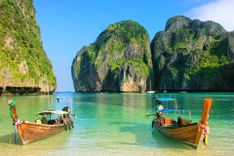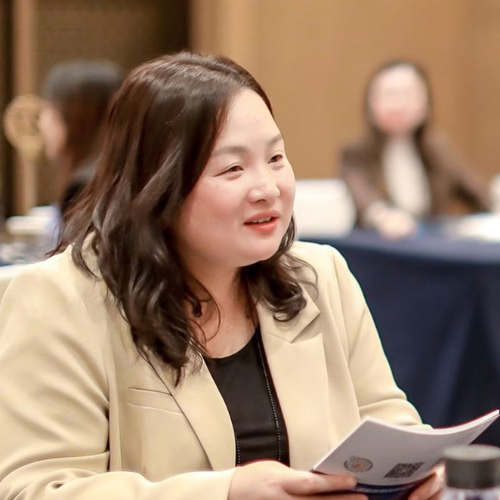Where to eat in Bangkok
As you’d expect, nowhere in Thailand can compete with Bangkok’s diversity when it comes to food: it boasts an astonishing fifty thousand places to eat, almost one for every hundred citizens.
The best gourmet restaurants in the country operate from the downtown districts, proffering wonderful royal, traditional and regional cuisines that definitely merit a visit.
At the lower end of the price scale, one-dish meals from around the country are rustled up at the food courts of shopping centres and department stores, as well as at night markets and street stalls, which are so numerous in Bangkok that we can only flag the most promising areas.
Chinatown naturally rates as the most authentic district for pure Chinese food; likewise neighbouring Pahurat, the capital’s Indian enclave, is best for unadulterated Indian dishes.
Thai cookery classes in Bangkok
8/91 Soi 54, Thanon Ngam Wongwan. Thorough, four-hour classes in a quiet, suburban house in northern Bangkok. B2200, including transfers from central hotels. Closed Sun.
233 Thanon Sathorn Tai (BTS Surasak). In a grand building, courses that range from B3300 for a half-day to a five-day private course for professional chefs for B90,000.
Klong Toey. A chance to experience the slums of Klong Toey and spend a morning learning to cook. B1200, including a market tour and free transfers from next to Phrom Pong BTS station. Closed Sun.
You can also book a Thai cooking class that includes a trip to Bangkok's largest market, Khlong Toei, to choose and buy your own ingredients before cooking them up.
Bangkok has a good reputation for shopping, particularly for antiques, gems, contemporary interior design and fashions, where the range and quality are streets ahead of other Thai cities. Silk and handicrafts are good buys too, though shopping for these in Chiang Mai has many advantages. As always, watch out for fakes: cut glass masquerading as precious stones, old, damaged goods being passed off as antiques, counterfeit designer clothes and accessories, pirated CDs and DVDs, even mocked-up international driver’s licences (though Thai travel agents and other organizations aren’t that easily fooled).
Downtown is full of smart, multi-storey shopping plazas like Siam Centre, Siam Paragon and Central World on Thanon Rama I and Emporium on Thanon Sukhumvit, which is where you’ll find the majority of the city’s fashion stores, as well as designer lifestyle goods and bookshops. The plazas tend to be pleasantly air-conditioned and thronging with trendy young Thais, but don’t hold much interest for tourists unless you happen to be looking for a new outfit.
Shopping centres, department stores and tourist-oriented shops in the city keep late hours, opening daily at 10 or 11am and closing at about 9pm; many small, upmarket boutiques, for example along Thanon Charoen Krung and Thanon Silom, close on Sundays, one or two even on Saturdays. Monday is meant to be no-street-vendor day throughout Bangkok, a chance for the pavements to get cleaned and for pedestrians to finally see where they’re going, but plenty of stalls manage to flout the rule.
If you're into shopping but not that much into haggling or doing the research, you can take a private driver and guide to take you to the best malls and plazas in Bangkok. The guide will help you haggle and find the best deals for your desired items and having a private car means never having to worry about dragging your shopping bags around the public transport.
Shopping for everyday stuff
You’re most likely to find useful everyday items in one of the city’s numerous department stores: seven-storey Central Chidlom on Thanon Ploenchit (daily 10am–10pm), which boasts handy services like watch-, garment- and shoe-repair booths as well as a huge product selection (including large sizes), is probably the city’s best. For children’s stuff, Central Chidlom also has a branch of Mothercare, as do the Emporium and Siam Paragon shopping centres. Meanwhile, the British chain of pharmacies, Boots the Chemist, has scores of branches across the city, including on Thanon Khao San, in Siam Paragon, in Central World, in Emporium and a late-night branch at the Thanon Suriwong end of Patpong 1.
The best place to buy anything to do with mobile phones is the scores of small booths on the third floor of Mah Boon Krong (MBK) Shopping Centre at the Rama I/Phrayathai intersection. For computer hardware and genuine and pirated software, as well as digital cameras, Panthip Plaza, at 604/3 Thanon Phetchaburi, is the best place; it’s slightly off the main shopping routes, but handy for Khlong Saen Saeb boat stop Tha Pratunam, or a longer walk from BTS Ratchathevi. Mac-heads are catered for here, including authorized resellers, and there are dozens of repair and secondhand booths, especially towards the back of the shopping centre and on the upper floors.
Having clothes tailor-made
Bangkok can be an excellent place to get tailor-made suits, dresses, shirts and trousers at a fraction of the price you’d pay in the West. Tailors here can copy a sample brought from home and will also work from any photographs you can provide; most also carry a good selection of catalogues. The bad news is that many tourist-oriented tailors aren’t terribly good, often attempting to get away with poor work and shoddy materials (and sometimes trying to delay delivery until just before you leave the city, so that you don’t have time to complain). However, with a little effort and thought, both men and women can get some fantastic clothes made to measure.
Choosing a tailor can be tricky, and unless you’re particularly knowledgeable about material, shopping around won’t necessarily tell you much. However, don’t make a decision wholly on prices quoted – picking a tailor simply because they’re the cheapest usually leads to poor work, and cheap suits don’t last. Special deals offering two suits, two shirts, two ties and a kimono for US$99 should be left well alone. Above all, ignore recommendations by anyone with a vested interest in bringing your custom to a particular shop.
Prices vary widely depending on material and the tailor’s skill. As a very rough guide, for labour alone expect to pay B5000–6000 for a two-piece suit, though some tailors will charge rather more (check whether or not the price you’re quoted includes the lining). For middling material, expect to pay about B3000–5000, or anything up to B20,000 for top-class cloth. With the exception of silk, local materials are frequently of poor quality and for suits in particular you’re far better off using English or Italian cloth. Most tailors stock both imported and local fabrics, but bringing your own from home can work out significantly cheaper.
Give yourself as much time as possible. For suits, insist on two fittings. Most good tailors require around three days for a suit (some require ten days or more), although a few have enough staff to produce good work in a day or two. The more detail you can give the tailor the better. As well as deciding on the obvious features such as single- or double-breasted and number of buttons, think about the width of lapels, style of trousers, whether you want the jacket with vents or not, and so forth. Specifying factors like this will make all the difference to whether you’re happy with your suit, so it’s worth discussing them with the tailor; a good tailor should be able to give good advice. Finally, don’t be afraid to be an awkward customer until you’re completely happy with the finished product – after all, the whole point of getting clothes tailor-made is to get exactly what you want.
Gem scams
Gem scams are so common in Bangkok that TAT has published a brochure about it and there are several websites on the subject, including the very informative w2bangkok.com/2bangkok-scams-sapphire.html, which describes typical scams in detail. Never buy anything through a tout or from any shop recommended by a “government official”/“student”/“businessperson”/tuk-tuk driver who just happens to engage you in conversation on the street, and note that there are no government jewellery shops, despite any information you may be given to the contrary, and no special government promotions or sales on gems.
The basic scam is to charge a lot more than what the gem is worth based on its carat weight – at the very least, get it tested on the spot, ask for a written guarantee and receipt. Don’t even consider buying gems in bulk to sell at a supposedly vast profit elsewhere: many a gullible traveller has invested thousands of dollars on a handful of worthless multicoloured stones, believing the vendor’s reassurance that the goods will fetch at least a hundred percent more when resold at home.
If you’re determined to buy precious stones, check that the shop is a member of the Thai Gem and Jewelry Traders Association, by visiting their website which has a directory of members (wthaigemjewelry.or.th). To be doubly sure, you may want to seek out shops that also belong to the TGJTA’s Jewel Fest Club (wjewelfest.com), which guarantees quality and will offer refunds; see their website for a directory of members.
Traditional massage and spas in Bangkok
Thai massage sessions and courses are held most famously at Wat Pho, while luxurious and indulgent spa and massage treatments are available at many posh hotels across the city, as well as at the following stand-alone places.
Divana Massage and Spa 7 Soi 25, Thanon Sukhumvit t02 661 6784, wdivanaspa.com; map. Delightful spa serving up Thai massages (100min for B1150), foot, aromatherapy and herbal massages, as well as facials and Ayurvedic treatments. Mon–Fri 11am–11pm, Sat & Sun 10am–11pm.
Nicolie Sun Square, a small shopping arcade on the south side of Thanon Silom between soi 21 and 23 t02 233 6957, wnicolie-th.com; map. Superb Thai (B1600/90min) and other massages, as well as facials and scrubs, in a soothing environment decorated with Asian objets d’art. Daily 11am–10pm.
Pian’s Soi Susie Pub, which runs between the east end of Thanon Khao San and Thanon Ram Bhuttri t02 629 0924; map. Uninvitingly clinical-looking but highly rated a/c massage centre, offering Thai massages (B200/hr) as well as foot, oil and herbal massages; you can also study Thai massage here. Daily 7.30am–12.30am.
Going out in Bangkok
Returning visitors to Bangkok will notice that its drinking and nightlife scene has thoroughly grown up in the past ten years, leaving notorious Patpong – and its neon-light sex bars – behind. Visit Bangkok now and you’ll find it offers everything from ‘illegal’ microbreweries (strictly speaking small-batch brewing is verboten) and rooftop cocktail bars to achingly cool clubs and dance bars, hosting world-class DJs.
Drinking and nightlife
The high-concept bars of Sukhumvit and the lively, teeming venues of Banglamphu, in particular, pull in the style-conscious cream of Thai youth and are tempting an increasing number of travellers to stuff their party gear into their rucksacks. During the cool season (Nov–Feb), an evening out at one of the seasonal beer gardens is a pleasant way of soaking up the urban atmosphere (and the traffic fumes). You’ll find them in hotel forecourts or sprawled in front of dozens of shopping centres all over the city, most notably Central World Plaza.
Among the city’s club nights, look out for the interesting regular events organized by Zudrangma Record Store at venues such as Cosmic Café, which mix up dance music from all around Thailand and from all over the world. Getting back to your lodgings should be no problem in the small hours: many bus routes run a (reduced) service throughout the night, and tuk-tuks and taxis are always at hand – though it’s probably best for unaccompanied women to avoid using tuk-tuks late at night.





